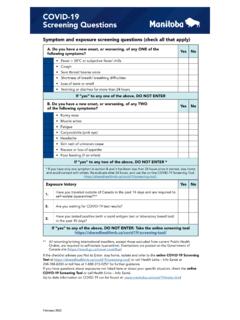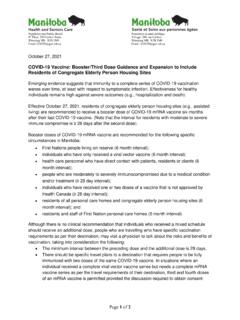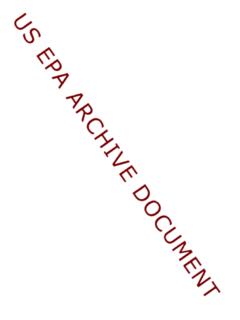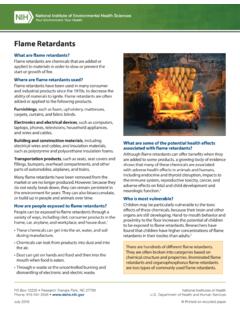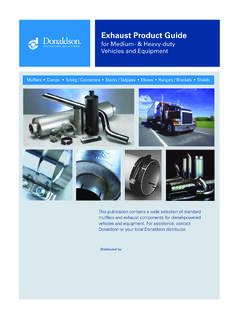Transcription of Guidance for Manitoba Businesses if an Employee Tests ...
1 COV ID-19 Guidance for Manitoba Businesses if an Employee Tests Positive for COVID-19 Introduction Employers play an important role in reducing the spread of COVID-19. If an Employee has tested positive for COVID-19, managers are able to take steps to quickly isolate and contain exposures in the workplace in order to reduce risk of further transmission. Acting quickly also maintains staff trust and helps to ensure that they feel informed and supported by their will I be notified if a worker is positive? In most cases, employees will notify you if they have tested positive for COVID-19, or have been identified as a close contact to someone who has tested some cases, you may be advised of a positive case or a close contact by a public health official.
2 Public health officials may also conduct an investigation to determine whether there was a risk of exposure in a workplace that places the public at risk. If the investigation finds there may be a risk, public health officials may issue a public notice. Do I have to identify the close contacts of positive employees? In most cases, individuals that test positive will be asked by public health officials to identify and notify their own close contacts. However, a positive diagnosis can be stressful for staff and concerning to employers. Managers can help by assisting the Employee who has tested positive to identify and notify any close contacts in the to help determine who is a close contact and resources on how to notify close contacts can be found at: It is important to ensure Employee s personal health information remains confidential.
3 To best protect an Employee s privacy, it is advised that the least amount of personal information possible be shared. Employers are also encouraged to maintain policies to protect the personal health information of staff. Information that may help to identify workplace close contacts include: Current Employee information, including their personal address, phone number and emergency contacts. Work schedules, email calendars or databases that contain work activity information. Records of work teams or cohorts. Carpooling arrangements, lunchbreaks or other off-hours social engagements involving staff, such as staff parties.
4 An employer may also decide to notify staff or visitors of a positive case in the workplace, while making sure to protect the name of the individual and ensure their personal health information remains confidential. A sample notification can be found in Appendix Health Factsheet January 2022 Will anyone else contact me or come to the workplace? In some settings, if a person was at work while infectious, public health officials may conduct an investigation to determine if there is additional risk to the workplace than what exists in the general community. At any time, a public health inspector from the Health Protection Unit and/or a safety and health officer from the Workplace Safety and Health Branch may visit a workplace to review measures in place to reduce the risk of COVID-19 and ensure compliance with provincial laws.
5 It is important to note that a visit from a provincial inspector does not mean you have a positive case in your workers need to isolate and get tested before coming to work?Generally speaking, not all employees in a workplace will need to isolate or be tested as a result of having a positive case in the workplace. Cases and close contacts are required to isolate in accordance with current public health requirements. More information about current isolation and testing protocols can be found online at: #vocWhat Can I Do to Reduce the Risk of Workplace Transmission? Simple steps can make a big difference in protecting your community and your workplace, including.
6 Get vaccinated and encourage all staff who are eligible to get vaccinated ensure staff practice physical distancing wash hands with soap and water for at least 15 seconds or use an alcohol-based hand sanitizer practice proper cough etiquette usewell-fitted, three layer masks or respirators, as applicable perform a daily health screening cohort workers (ensure regular work groups to minimize the number of contacts for each worker) instruct employees to stay at home when sick, even if symptoms are mild increase cleaning and sanitizing in accordance with the Guidance in Appendix 2 Reference materialsCOVID-19 and current public health orders: resources and guidelines at Work Manitoba : Centre for Occupational Health and Safety 1 Sample memo notifying employees of a positive case in the workplaceAn Important Update<<DATE>>Today we were notified that one of our staff has been confirmed to have the COVID-19 virus.
7 At this time, the Employee is in self-isolation. Individuals identified as close contacts have been notified and are isolating in accordance with the public health are currently taking all necessary precautions to reduce the risk of COVID-19 transmission in the workplace and ensure the safety of our employees and do know that COVID-19 is a risk in our communities. We encourage everyone to take precautions and follow key public health fundamentals, including: getting vaccinated if you re eligible to get vaccinated, staying home if you re sick, even if symptoms are only mild; washing your hands at least 15 seconds or using an alcohol-based hand sanitizer.
8 Practicing proper cough etiquette and maintaining physical distancing when you do have to go public health orders can be found at information on COVID-19 can be found at your employer, we want to let you know that we are here to support you and answer any additional workplace-related concerns and questions during this difficult you,<<OWNER>>APPENDIX 2 Cleaning and Disinfection Guidelines After Known Positive COVID-19 Cases Companies do not necessarily need to close operations. If possible, they can close off areas used by the person who was sick to allow cleaning to occur. Clean and disinfect all areas used by the person who is sick, such as offices, bathrooms, common areas, shared equipment and tools such as tablets, screens, keyboards, remotes etc.
9 Manual surface cleaning with detergent and water using applied friction ( brushing, scrubbing) must be performed first to ensure physical removal of organic materials, followed by use of a cloth or wipe which is soaked in the disinfectant. Use a Health Canada-approved disinfectant that is effective in killing the COVID-19 virus and follow manufacturer s instructions on concentration and contact time required. A link to Health Canada s approved disinfectants for COVID-19 can be found at: Vacuum the space if needed. Use a vacuum equipped with high - efficiency particulate air (HEPA) filter, if available. If possible, temporarily turn off in-room, window-mounted, or on-wall recirculation HVAC to avoid contamination of the HVAC units.
10 Do not deactivate central HVAC systems. These systems tend to provide better filtration capabilities and introduce outdoor air into the areas that they serve. If possible, increase air circulation and filtration in the area. Once the area has been disinfected, it can be opened for use. Continue routine cleaning and disinfection. This includes everyday practices that Businesses and communities normally use to maintain a healthy : The application of disinfectants to environmental surfaces via spraying or fogging (also known as fumigation or misting) in indoor spaces is not recommended as a stand-alone method. If fogging does take place, organic material must be removed before using a Health Canada-approved disinfectant for fogging.



